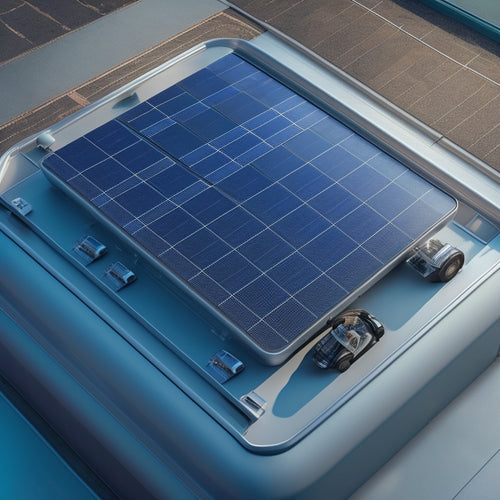
3 Essential Steps for Installing Solar Setup for Houses
Share
You'll want to start by evaluating your energy needs, calculating your total energy consumption and identifying peak hours of usage to determine the right system size for your house. Next, prepare your home's roof by inspecting for damaged shingles, conducting a shading analysis, and ensuring a solid foundation for the solar setup. Finally, install the solar panels, choosing the right type, securing the mounting system, and connecting the panels to the inverter while avoiding damage and ensuring compliance with local codes - and that's just the beginning of your expedition to utilizing the power of the sun.
Key Takeaways
- Assess energy needs by calculating total energy consumption, identifying peak hours, and evaluating energy efficiency of appliances and systems.
- Prepare the home's roof by inspecting for damage, conducting a shading analysis, and trimming trees or removing obstructions to minimize shading.
- Install solar panels by choosing the appropriate type, securing the mounting system, and connecting panels to the inverter while ensuring compliance with local codes.
- Ensure a solid foundation for the solar setup by repairing roof issues and using online energy calculators for accurate assessments.
- Consult with solar experts for a tailored energy needs evaluation and to ensure a successful solar setup installation.
Assess Your Energy Needs
Determining your energy needs is an essential step in designing an effective solar setup for your house. You need to calculate how much energy your house consumes to determine the size of the solar panel system required to meet your energy demands.
Review your past utility bills to get an idea of your energy consumption patterns. Identify the peak hours of energy usage and the total kilowatt-hours (kWh) consumed per month.
Consider the energy efficiency of your appliances, lighting, and HVAC systems. Are they energy-intensive or energy-efficient? This information will help you determine the total load requirement for your solar setup.
You can also use online energy calculators or consult with a solar expert to get an accurate assessment of your energy needs.
Prepare Your Home's Roof
With your energy needs evaluated, you can now focus on preparing your home's roof for the solar setup. This vital step guarantees your roof is ready to support the solar panels and maximize energy production.
Start by examining your roof's condition, checking for damaged, missing, or loose shingles, curled or buckled shingles, and signs of wear around chimneys, vents, and skylights. Repair or replace any damaged sections to create a solid foundation for your solar setup.
Next, conduct a shading analysis to identify areas of your roof that receive partial or full shading throughout the day. This is essential, as shading can greatly reduce your solar panel's energy output.
Use tools like a solar pathfinder or a shade analysis app to determine the best placement for your solar panels. Consider trimming trees or removing obstructions to minimize shading and optimize energy production.
Install Solar Panels
You've prepared your roof for the solar setup, now it's time to install the solar panels. This essential step requires precision and attention to detail to guarantee maximum energy harvesting.
Select the suitable solar panel type for your setup, considering factors like efficiency, durability, and cost. Monocrystalline and polycrystalline panels are popular options, each with their advantages and disadvantages.
Begin by securing the mounting system to your roof, guaranteeing a watertight seal. Next, connect the solar panels to the mounting system, following the manufacturer's instructions.
Take care to avoid damaging the panels during installation, as this can compromise their performance. The installation costs may vary depending on the complexity of the setup, local labor rates, and the number of panels required.
Properly connect the panels to the inverter, which converts DC power to AC for your home's electrical system. Verify all electrical connections are secure and meet local building codes.
A well-executed installation will provide you with clean, renewable energy for years to come.
Frequently Asked Questions
Can I Install Solar Panels on My Own?
You can attempt a DIY installation, but be aware that it's essential to take necessary safety precautions to avoid electrical shocks and falls, ensuring a safe and successful installation that meets local building codes and regulations.
How Long Does a Solar Panel System Last?
You might think solar panels are a fleeting investment, but you'll be relieved to know that a well-maintained system can last up to 30 years or more, with the solar panel lifespan heavily influenced by factors affecting longevity, such as quality, installation, and environmental conditions.
Are Solar Panels Affected by Weather Conditions?
You'll find that solar panels' efficiency is indeed affected by weather conditions; extreme temperatures, humidity, and precipitation can reduce their performance, but don't worry, manufacturers design them to withstand weather impact, ensuring you still generate power efficiently.
Can Solar Panels Be Used for Heating Water?
You're a million times smarter for asking: can solar panels be used for heating water? Yes, you can utilize solar power to fuel your water heating systems, and it's a breakthrough, providing a sustainable, cost-effective solution for your daily hot water needs!
Do Solar Panels Require Regular Maintenance?
You'll need to perform regular solar panel cleaning to guarantee maximum energy output, and invest in efficiency monitoring to detect potential issues, as neglecting these tasks can lead to reduced performance and energy losses over time.
Related Posts
-

Top Solar Panels for Car Battery Maintenance
When selecting top solar panels for car battery maintenance, consider high-efficiency models with high wattage output...
-

Planning for an Electric Vehicle-Friendly Urban Future
As you plan for an electric vehicle-friendly urban future, you'll need to integrate high-power charging stations, sma...
-

Best Solar Panel Options for Maximum Energy Savings
You can maximize your energy savings with solar panels that boast efficiency ratings above 20%, paired with extensive...


